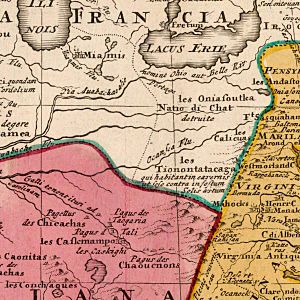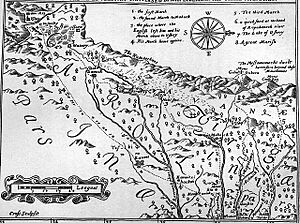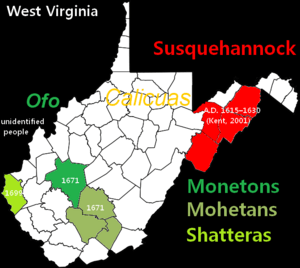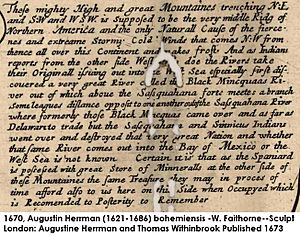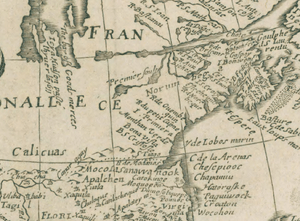Moneton facts for kids
The Moneton were a Native American tribe who lived in what is now West Virginia. In the late 1600s, they lived in the Kanawha Valley, near the Kanawha and New Rivers.
Contents
Moneton: Name and Language
Quick facts for kids Moneton |
|
|---|---|
| Native to | United States |
| Region | West Virginia |
| Extinct | late 17th century? |
| Language family |
Siouan
|
We don't know what the Moneton people called themselves. In the 1670s, an explorer named Abraham Wood wrote their name as "Moneton" and sometimes "Monyton."
Many experts believe the Moneton language was part of the Siouan language family. This family includes languages like Tutelo. The Moneton lived near other Siouan-speaking groups and also close to areas where Iroquois dialects were spoken.
Moneton History: What We Know
The Moneton tribe lived in the western part of what was then Colonial Virginia. Some historians think the Moneton might have been part of a larger group called the Monacan. Different spellings of their names were common back then.
Early Explorations and the Moneton Tribe
The word "Moneton" is thought to come from the Siouan language. Some researchers also suggest it could be from the Cherokee language. Early explorers like Batts and Fallam were told by the Mohetan (another tribe) that Moneton villages were about halfway between Peters' Mountain and the Ohio River.
Words like "Mon," "Ma," and "Man" in Siouan languages often mean "a people's land." "Mone" can mean "water," and "ton" can mean "large." This might give us clues about the Moneton name.
Other Tribes in the Moneton Area
Another tribe, the Tomahittons, was also reported in the Ohio Valley. Reports about this tribe from the Mohetan matched what the Moneton told another explorer named Arthur. Batts and Fallam are known for discovering Kanawha Falls.
The Iroquois League, Huron Confederacy, and Conestoga tribes were powerful groups. The Conestoga acted as traders, getting firearms from the Dutch and selling them to other tribes. Their main villages were near the New York and Pennsylvania border, along the Susquehanna River.
Archaeological sites in Grant County, West Virginia, Hampshire County, West Virginia, Hardy County, West Virginia, and Allegany County, Maryland have found Conestoga pottery. A Conestoga site is also located at Moorefield, West Virginia.
Explorers Batts and Fallows traveled through the southeastern Allegheny Mountains of West Virginia in 1671. Their records mention the arrival of the Les Tionontatacaga, also known as the Guyandotte, named after the Guyandotte River in Cabell County.
Early History of the Region
Some early researchers believed there was no proof that Siouan-speaking tribes lived in this area. However, other experts, like James Mooney, listed the Mohetan as one of several groups clearly part of the Siouan family.
The "Calicuas" tribe was reported near Cherokee Falls (Valley Falls) in 1705. An Indian trading post from 1731 suggests some Calicuas were still in the area. The Moneton might also have been a distant branch of the Cherokee tribe. They were known to be unfriendly with the Shawnees, who lived near the Scioto River.
Related Nations
The Moneton tribe shared connections with other Native American groups. These include:
|


